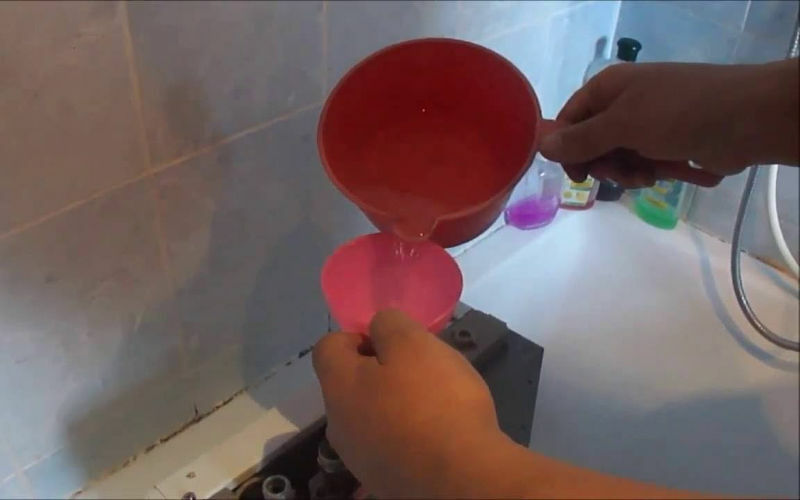Like any other mechanism, the water block has wearing parts in its design. When they become unusable, the operation of the heater deteriorates or stops altogether. Familiar situation?
In the event of a malfunction, the home craftsman is quite capable of repairing the water unit of the gas column on his own, disassembling the gearbox and replacing his spent consumables. To begin with, we propose to figure out how to personally disassemble and repair the water unit of the instantaneous water heater device. The information will also come in handy when performing preventive examinations. We will provide the presented material with thematic photos and video materials.
The content of the article:
- Purpose of the water unit
-
Frog device instantaneous water heater
- The principle of operation of the venturi connection
- How does the frog membrane work?
- Purpose of the retarder ball
- On the role of the plate and stem
- Bypass and other gearbox innovations
- Preparation for the repair of the water unit
- Possible frog malfunctions
-
Diagnosis of causes and elimination of breakdowns
- Problem # 1 - low pressure of hot water
- Problem # 2 - the column does not turn on
- Problem # 3 - turning on the speaker with a delay
- Problem # 4 - the column works after the tap is closed
- Problem # 5 - the water heater is not picking up power
- Problem # 6 - no clicks are heard when firing up
- Problem # 7 - there is a water leak from the gearbox
- Problem # 8 - when the water is turned on, the stem is inactive
-
Rules for dismantling and disassembling the gearbox
- Removing the reducer from the column
- Dismantling the water regulator
- Reassembling the frog
- Repaired node testing
- Conclusions and useful video on the topic
Purpose of the water unit
Regardless of the complexity of the design, gas water heaters used to heat water in houses where there is no hot water supply (hot water supply) operate according to the general principle. The water passing through the heat exchanger is heated by gas, which is supplied to the burner when a liquid flow through the water unit appears and is closed when the hot water tap is closed.
The water unit is the first automatically operating geyser unit on the cold water path.
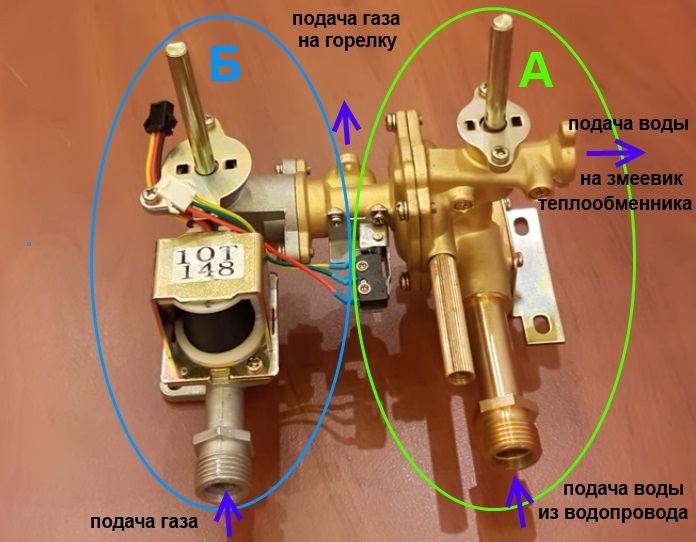
The water unit (A) is located at the very beginning of the path taken by water along the water "main" of the gas column, therefore it is easily detected after removing the case. Structurally, the unit is connected with the gas unit (B) and the heat exchanger
The main task of the water block is signaling to turn on or off the gas unit operating in steam with it, adjust the gas supply to the burner and the water supply to the heat exchanger coil (ensuring the normal operation of the column).
Thanks to the original internal structure, when the hot water tap is opened, the water reducer gives a signal:
- to the opening of gas provided that the flow rate of heated water is not lower than that provided;
- to cut off the gas supply when the tap is turned off or the pressure of hot water is insufficient.
At the same time, a water reducer (aka a frog, or a water regulator) is one of the safety devices water heater, since with a low water pressure, it prevents overheating of the heat exchanger, which from regular overheating fails. O repair of the heat exchanger we talked about in our other article.
Frog device instantaneous water heater
In order not to do blind repairs, you need to understand how a particular unit works. For a better understanding of the purpose of the parts and the principle of operation, consider the device of the water block of a gas column used in everyday life. Let's do this using one of the most common columns as an example - Neva.
The water reducer is colloquially called the heart of the water unit. The body of the "heart" consists of two parts - the base and the cover, which are connected with screws. In the Neva, the body is made of brass. In modern columns, gearboxes are also made of silumin, polyamide or high-strength plastic.
In the lower part of the base, there are revision holes for water drainage, plugged with screws.
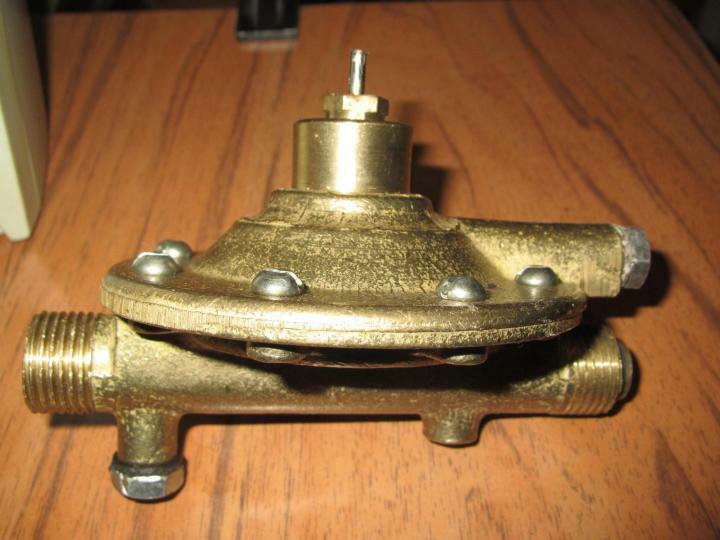
The body of the regulator is made of brass. The base and the cover are connected by 8 screws, which, before screwing during reassembly, it is advisable to lubricate with graphite grease or lithol
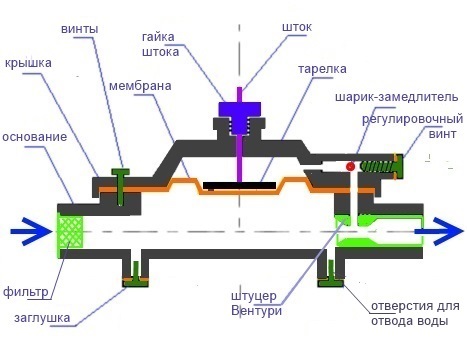
The internal structure of the water unit reducer is thought out to the smallest detail. Everything is simple and reliable, therefore it is dismantled only to replace consumables
The base has two nozzles. Water enters the frog through the inlet. With the help of a union nut, the branch pipe is connected to the water supply pipe. There is also a sealing gasket that protects against leaks, and a filter mesh that protects the inside of the frog from debris from entering the water. The presence of the filter prolongs the life of the membrane, which is especially sensitive to the presence of debris, which acts during the flow of water and the movement of the membrane like an abrasive.
The outlet is equipped with Venturi fitting. The pipe is connected with a pipe through which water from the reducer goes to the coil of the heat exchanger with a union nut. A gasket is also installed here. Above the constricted part of the venturi in the base body, a bypass hole is made through which water from the lower cavity of the regulator through the fitting enters the upper cavity separated by the membrane - under the cover.
The gear cover is shaped like an inverted bowl. In its center there is a channel for passing the stem and installing a sleeve equipped with a nut. At the lower end of the stem (on the inner side of the cover), there is a disk of the disc in contact with the membrane (diaphragm). The upper end of the stem mechanically transmits a signal to the valve of the gas block.
On the side of the cover, there is a bypass equipped with an adjusting screw and a retarder ball made of metal or plastic. The lower opening of the channel (when connecting the halves of the body) coincides with the bypass opening of the base. The ball channel works like a ball valve.
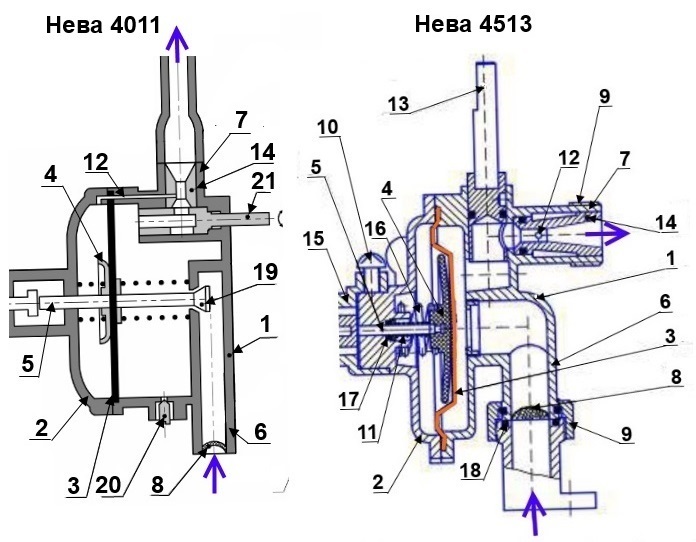
Design of the water part of the water-gas unit of the Neva GK. The numbers indicate: 1 - base, 2 - cover, 3 - membrane, 4 - plate, 5 - stem, 6 - inlet pipe, 7 - outlet pipe, 8 - mesh filter, 9 - union nut, 10 - fastening screw connecting GU and VU, 11 - stem sleeve, 12 - bypass channel, 13 -, 14 - Venturi fitting, 15 - gas block branch pipe, 16 - stem spring, 17 - stem gland, 18 - sealing gasket, 19 - water flow limiter, 20 - water drain hole with plug, 21 - regulator water flow
A membrane is located between the cover and the base - it performs the main function of the unit. Previously, membranes were made of rubber. Of modern materials, silicone is the best. There are also combined - rubber-metal diaphragms. Along the edge of the diaphragm disc, there are fastening screw holes and a bypass hole.
The principle of operation of the venturi connection
In order to understand in detail the principle of operation of the frog, we understand how the individual parts of the device work. Let's start with the Venturi connection. It is a tubular cylinder, in the channel of which an artificial narrowing is made. Narrowing of the channel causes an increase in the flow rate and a decrease in pressure at the bottleneck.
As a result, there is a difference in fluid pressures:
- before narrowing, the water presses on the walls with greater force;
- in a narrow place where the flow rate is maximum, the pressure is lowered.
Where the pressure in the fitting is minimal when the tap is opened, a bypass channel begins, through which water from the lower cavity of the frog enters the upper one. When the tap is closed, there is no water flow to the coil. Differences in pressure in the choke and in front of it - too. In both communicating cavities of the reducer, the pressure is the same. The membrane is positioned in the middle.
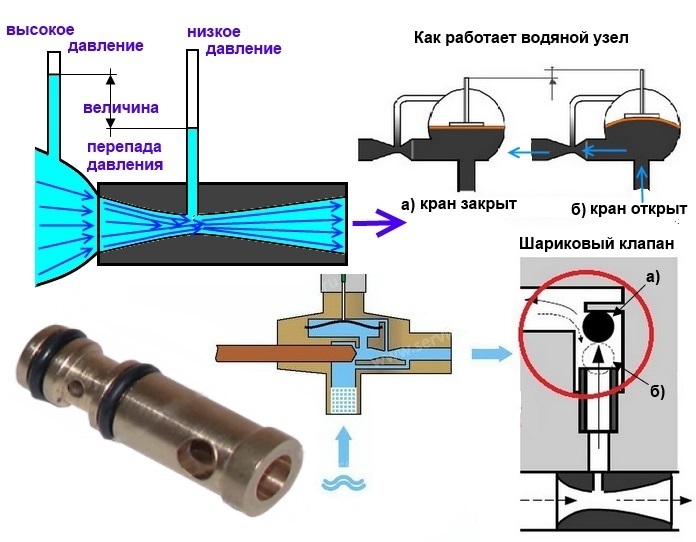
The design of the venturi is responsible for the occurrence of pressure differences. Pressure with closed (a) and open (b) hot water taps. How the ball valve works.
The water pressure in the lower cavity is a constant value equal to water pressure in the water supply. The water pressure in the upper cavity of the frog is a variable quantity. The maximum pressure in it, equal to the water pressure in the water supply system, is achieved when the hot water tap is closed. With the valve fully open, the flow rate at the point of the choke constriction is maximum. The pressure in the bypass channel decreases to a minimum, followed by a decrease in the water pressure in the upper cavity of the reducer.
How does the frog membrane work?
When you open a hot water tap and a pressure difference appears, membrane, trying to bend upwards, presses with force on the plate, rigidly fixed to the rod. The stem extends outward and transfers force to the valve of the gas block, which is responsible for turning on the gas supply to the burner. The pressure drop is sufficient to generate the necessary force due to the area of the diaphragm, transfer it through the disc to the stem and overcome the elasticity of the spring mounted on the stem.
When the tap is closed, the flow of water in the column stops, the pressure difference disappears. The diaphragm returns to its original position, ceasing to press on the stem. The spring moves the stem back and the gas valve closes.

Membranes can be made of rubber, plastic or silicone. Their shape corresponds to the configuration of the frog, so sometimes it is difficult to find the right model to replace
From all that has been said above, it becomes clear that the membrane is one of the most important parts of the unit, which ensures its automatic operation and works "for wear." It is the violation of the integrity of the membrane that is most often the reason for the failure of the water unit.
Purpose of the retarder ball
If you remove and shake the cover of the water reducer, you can hear a metal ball rolling in it with a thud. It can be seen by unscrewing the adjusting screw. A small steel (or plastic) pea, when the column is turned on and off, rolls along the bypass channel, then partially blocking its lumen, then freeing up more space for overflow water.
Rolling back in the direction of the screw when the tap is turned on, the ball partially blocks the channel lumen. Water leaves the upper cavity slowly, so the gas valve opens smoothly. When the tap is closed, the pea is displaced in the opposite direction, the gap is quickly cleared, and the pressure drop is eliminated. Therefore, the gas water heater turns off quickly.
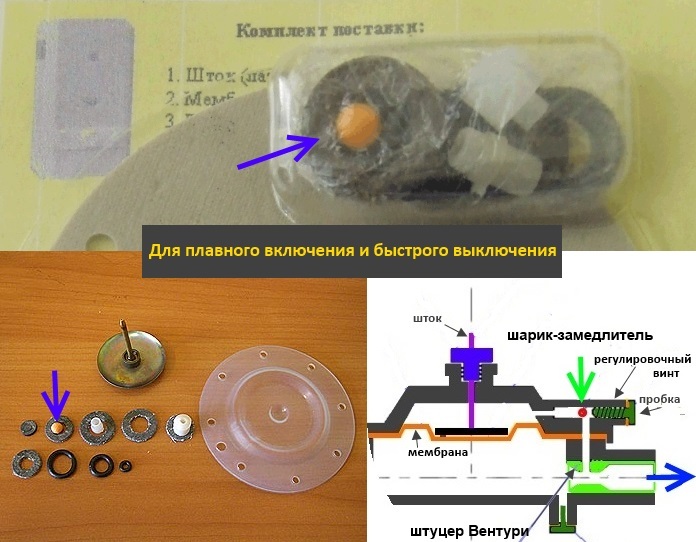
Retarder ball can be purchased together with a repair kit. Removing the ball or improper adjustment can cause the gas to turn on quickly, accompanied by a popping sound.
In this way, the smooth opening of the gas and its rapid shutdown are also carried out automatically, therefore the channel with the ball is also called the ball valve. The smoothness of gas opening is regulated by means of an adjusting screw hidden under the screw cap. This is done in extreme cases, since the gearbox is usually well adjusted by the manufacturer.
On the role of the plate and stem
Assembled, these two parts look like a mushroom with a cap. The stem is a metal rod that extends when the hot water tap is turned on towards the gas block.
At one end of the rod, a plastic plate is attached, which, bending, pushes the membrane, the other end of the rod pushes against gas unit valveopening the gas supply to the burner.
To prevent water leaks into the gas supply channel and onto the microswitch platform, several oil seals are installed in the stem connections.

The picture shows the most common stock configuration. On the axis (1) of the stem are strung (in order from the water to the gas unit): a nut (2) with a sleeve (4), with which the stem is attached to the gearbox perpendicular to the diaphragm; stem oil seal (not visible) built into the bushing; stem sleeve oil seal (3); rod skirt (5) - serves to control the position of the microswitch platform foot (MB); stem spring (6) ends with a small skirt; stem oil seal (7)
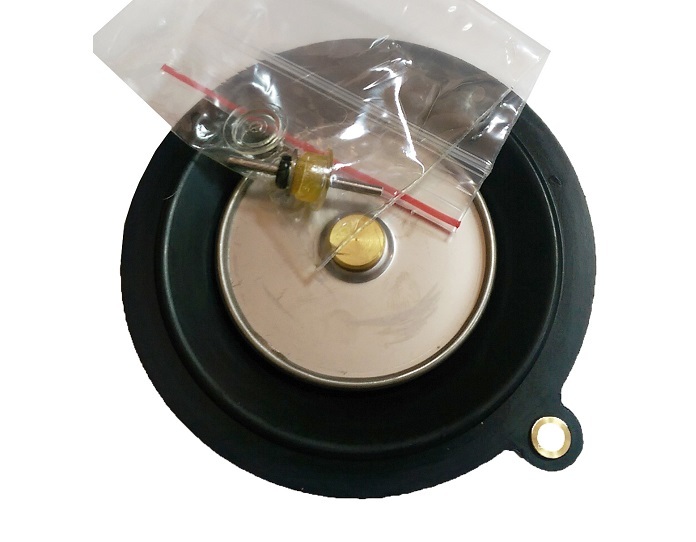
In some models of water reducers, the plate and the membrane are combined in one piece - a reinforced membrane. Reinforced diaphragm has a strict orientation relative to the stem axis, so the stem seal lasts longer, and the diaphragm is more durable
In modern models, the gas valve control mechanism is duplicated. It is switched on mechanically (by pressing the stem on the valve) and using a microswitch. In the latter, when the foot is retracted (by the extending rod), a closure is made and a signal is given to open the valve.
Bypass and other gearbox innovations
In modern water heaters, for example, the Electrolux brand, you can find improvements - bypass with water flow regulator. This is a channel parallel to the Venturi tube, the flow of water through which is regulated.
When the bypass is closed by the regulator, all the water flows through the nozzle, therefore, the pressure difference is maximum, the gas opens at full capacity. When the bypass is opened, the flow of water through the venturi is reduced, which also reduces the pressure drop and the gas valve opens less. The heating temperature of the liquid decreases.
In the same columns, the base of the case is equipped with valvethat regulates the flow of water through the frog (feedback device). If the pressure in the water supply line increases, the valve will partially close and open wider when the pressure decreases.
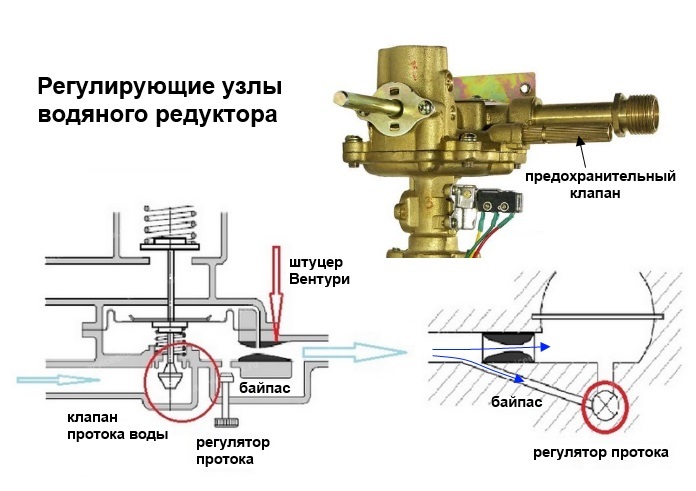
Water reducers of modern dispensers are equipped with several regulation and protection systems. Water flow valve eliminates water pressure surges
Another of the protective devices of the water unit is safety valve, relieving pressure and thereby protecting against rupture of the column pipe. It consists of a tube, the end of which is closed with a stopper, and inside there is a retaining valve (by a spring, the compression force of which is regulated by a clamping screw). If there is a leak in this area, tighten the clamping screw a little tighter.
Preparation for the repair of the water unit
Often, disassembling a frog to install a new membrane, you may find that in addition to it, one or more gaskets of different diameters must be replaced. Therefore, you need to start repairs by purchasing in advance a complete repair kit for the water unit, corresponding to the model of your gas water heater.
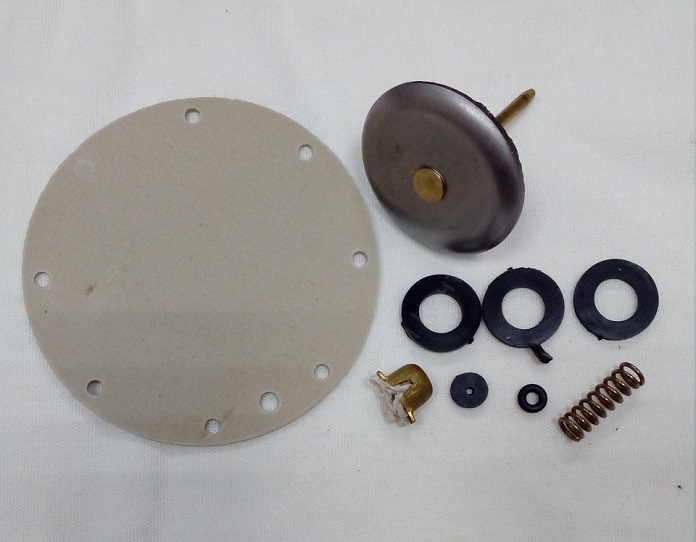
For repairs or preventive maintenance, it is most rational to stock up on a repair kit, since when disassembling the water reducer, it may become necessary to replace not only the membrane, but also several others details
In addition to spare parts, you will need a tool. For older units: adjustable wrench, screwdrivers for straight and Phillips screws. For modern models of "Neva" and Chinese water heaters, you will need a screwdriver with a Ph2 bit, preferably magnetized. There are also devices with "tricky" fasteners. It will not be superfluous to use a remedy to solve the problem of sour screws, for example, WD-40.
You will also need two adjustable gas wrenches. They are necessary so that during disassembly and re-installation while screwing on the fittings (flexible hoses or fittings), do not damage the fittings of the unit.
When excessive forces are applied in the fittings, microcracks, or hidden cracks, which are not visible from the outside, may form. To prevent this from happening, hexagonal pads are made on the fittings, which are held against displacement by one of the keys. The second key is used to fasten or unscrew the fittings.
Possible frog malfunctions
The body of the water regulator is robust, designed to operate at high water pressure (flow rate up to 3 m3/час). There are few parts in the water unit that may become unusable and cause breakdowns of the gas column.
Possible malfunctions:
- membrane break;
- violation of the integrity of the plastic plate - the diaphragm cannot move the stem;
- scale formation on the piston rod, slowing down the movement of the rod or leading to its jamming, which occurs due to the leakage of the stuffing box;
- retarder ball destruction (very rare, but it happens), channel clogging, ball jamming;
- debris full of filter mesh, which reduces the water pressure due to blockage of the passage;
- debris entering the venturi due to which the pressure in the hot water tap decreases, the column does not work;
- wear of gaskets, oil seals - this is the cause of leaks, leading to the formation of limescale.
Most of these malfunctions have characteristic symptoms that can be detected by external examination.
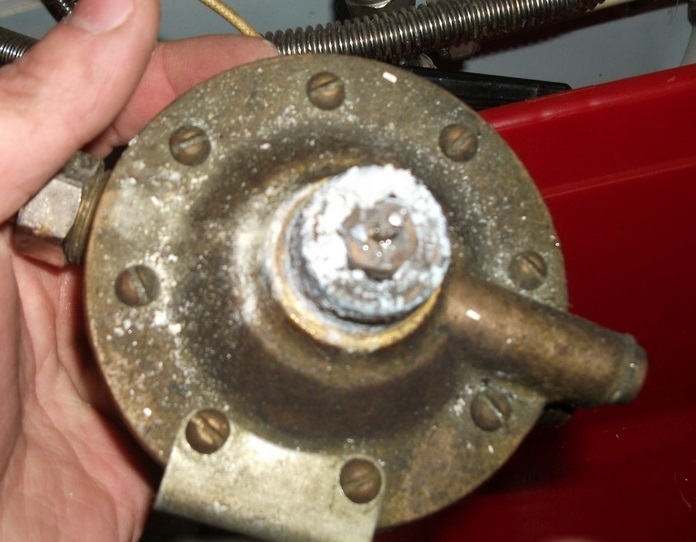
A leaking gland gasket will result in scale build-up and souring of the stem. All limescale must be removed. Unscrew and clean the bushing, replace the gasket and seals, clean and lubricate the stem
Any leaks require intervention that should not be postponed for long. Prolonged exposure to water will oxidize the contacts. As a result, the microswitch becomes unrepairable, completely unusable.
Diagnosis of causes and elimination of breakdowns
Most of the internal violations can be detected already with external diagnostics, testing the operation of the column. External symptoms, indicating a malfunction of the frog, most often point to the immediate culprit. Only part of the external manifestations can be the result of various reasons, which will become clear after dismantling the water unit.
Problem # 1 - low pressure of hot water
If the pressure in hot water is less than cold water, the reason may be filter mesh blockage. It is eliminated by cleaning, which does not require disassembling the frog, however, more often this reason is not the only one, therefore, the VU should be disassembled, at least for the purpose of prevention.
Another reason - blockage of the venturi channel. In this case, the gearbox is disassembled, the fitting is unscrewed and cleaned.
We considered other reasons for the weak water pressure in the column in this article.
Problem # 2 - the column does not turn on
If the column does not turn on with sufficient water pressure, then it is possible diaphragm break. It is eliminated by dismantling the frog and replacing the membrane. The best replacement option is silicone. Normal - to "native" (sold separately or in a repair kit). Not the best - a replacement for a suitable one or one made by yourself.
Another reason - souring of the stock. Remedy: the gearbox is disassembled, the stem is descaled, ground and lubricated with mineral oil, and the oil seals are replaced.

Breakage of the water reducer plate is less common than diaphragm breakage. The replacement part must be used with a native one, for this it is more rational to purchase a repair kit
Also among the possible reasons plate breakage. Without it, the diaphragm is unable to move the stem. Eliminated by replacement.
Problem # 3 - turning on the speaker with a delay
If, when opening a hot water tap, the column turns on with a significant delay, this may be due to incorrect ball valve adjustment (the adjusting screw has been removed unnecessarily). To fix the screw, screw it in a few turns.
More reasons: bypass clogging or retarder ball jamming. Need to parse the frog. The blockage is removed by cleaning the channel with a thin wood stick and rinsing. The ball can be removed by unscrewing the plug and adjusting screw.
Problem # 4 - the column works after the tap is closed
If the column, after closing the tap, continues to work for some time, and then turns off, most likely the reason lies in incorrect adjustment of the smoothness of inclusion. The adjusting screw must be unscrewed by making a few turns. To adjust the smoothness of the gas turn on, unscrew the plug, then use a screwdriver to screw in the adjusting screw a few turns to speed up the gas supply, or unscrew a few turns - to deceleration.
Also, the cause of this problem may be sticking microswitch. From the ingress of flowing water, its internal contacts are deformed and cracked. The device is replaced with a new one. After replacing the microswitch, the test column is turned on for a couple of minutes and turned off. The leak itself is a reason to dismantle the frog and revise the stem oil seals.
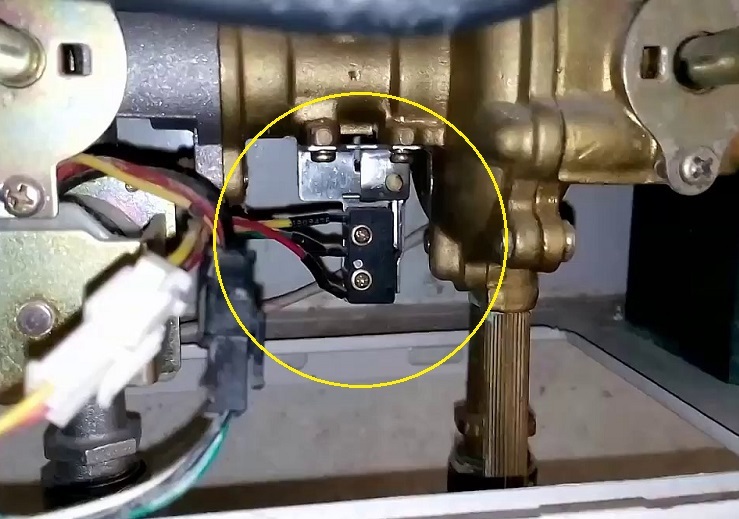
The microswitch is installed on a platform attached to the water part of the unit. To protect against leaks, the body of a new part is lubricated with lithol or grease.
Another reason is the appearance interference with the free movement of the stem. Two options are possible: the reason is in the design of the gas part or in the malfunction of the water unit. In the latter case, the stem may be delayed by the formed scale or not move due to broken springs. The gearbox is disassembled, cleaned and, if necessary, parts replaced.
The last two faults (sticking rod and microswitch) can lead to serious consequences. Immediate elimination required.
Problem # 5 - the water heater is not picking up power
The full capacity of the heater is not reached, and the blue flame of the burner is sluggish and goes out during operation. The most likely reason is leaky membrane. Eliminated by replacement.
Problem # 6 - no clicks are heard when firing up
If (with the wick ignition of the burner) the jet is cleaned, but the flame is dancing too far from the edges of the burner, its tongues are more than 3-5 cm, then the diaphragm has broken. It is required to disassemble the assembly and replace the membrane.
Problem # 7 - there is a water leak from the gearbox
The main reason is the wear of the gaskets or oil seals. Make a replacement.
Problem # 8 - when the water is turned on, the stem is inactive
In some models, the movement of the stem can be observed visually. If the stem remains stationary when opening the hot water tap or does not extend to its full length, then the matter is leaky membrane or in plate breakage, which will become clear when parsing the frog.
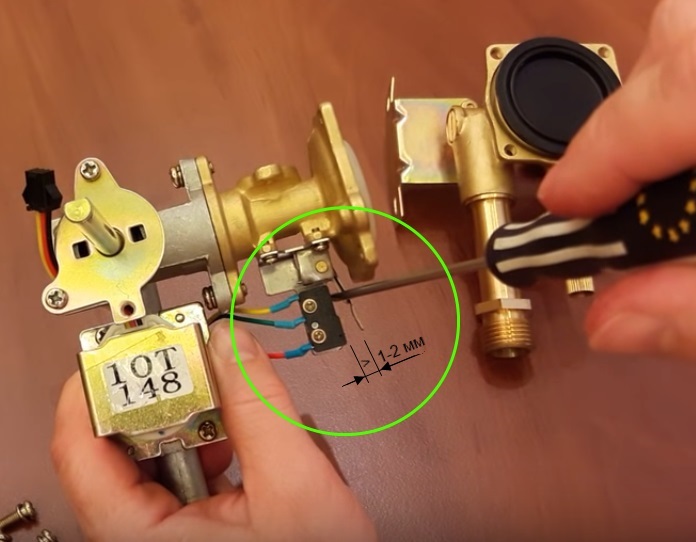
In columns with a microswitch, if the stem plate breaks or the membrane breaks, the platform foot does not return to the microswitch, but remains at a distance of more than 1-2 mm from it. After closing the hot water, the gas continues to burn, and the column is turned off by a thermal relay. If the distance does not exceed 1-2 mm, the presser foot can be carefully folded up until it is completely seated.
Such damage is eliminated by replacing the damaged plate or membrane. Before disassembling the unit, it is advisable to stock up on new gaskets and oil seals.
Rules for dismantling and disassembling the gearbox
Regardless of which modification of the gas water heater, before starting repairs or preventive maintenance, turn off the gas and cold water supply to the unit.
To drain water from the system, open the hot water tap located below of all water-folding devices powered by the column. We place a wide container (basin or bucket) under the water unit to be dismantled, where the remaining water from the reducer will be drained.
Removing the reducer from the column
Often the frog can be removed separately. But in some columns it is impossible to do this, so you have to dismantle both blocks together. There are models of instantaneous water heaters, in which, in order to gain access to the insides of the frog, it is not at all necessary to dismantle it - it is enough to remove the lid.
Dismantling the frog of the water heater "Neva 3208"
It is easy to dismantle the reducer in the column "Neva 3208", as in other similar devices. To do this, unscrew the union nuts on the inlet and outlet nozzles of the body, and also unscrew the three screws with which the frog is attached to the gas unit. When unscrewing the nuts and screws fixing the water regulator, hold the unit to be dismantled with your hand so as not to accidentally deform the parts of the gas unit.
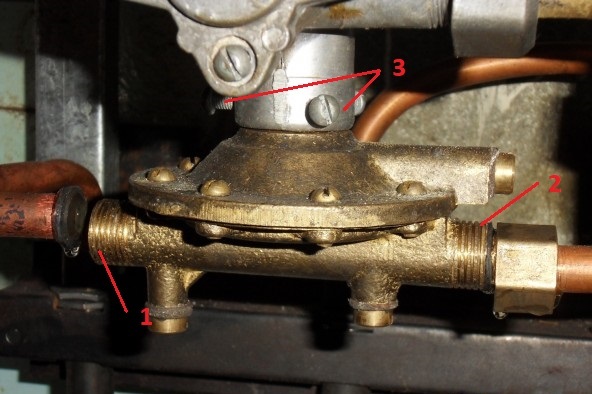
When dismantling the water regulator with a wrench, in the indicated order, unscrew the 2 union nuts of the branch pipes, then unscrew the 3 screws with a screwdriver
The procedure for removing the gearbox "Neva-transit"
To repair the water reducer, it must be removed from the column case. We will analyze how to do this using the example of dismantling the Neva-Transit column, since the fastening of gas-water units in many modern models is very similar. First, remove the control knobs on the front panel. They are simply put on stocks.
After that, unscrewing the screws, remove the front panel. Please note that the digital display on the front panel is connected with detachable terminals to the electronic devices of the speaker. Therefore, pushing the panel towards ourselves, disconnect the terminals and only then remove the panel completely.
Further, we will consider the process of removing the water unit in the next photo collection.
Image gallery
Photo from
After removing the front panel, you need to unscrew the two screws connecting the heat exchanger tube to the water part through the pressure plate. To free access to the screws, the battery box (B) is disconnected from the speaker case. After removing the box from the road, unscrew both screws (1 and 2), access to which is possible through the blinds in the side wall of the column
After disconnecting the microswitch and the solenoid valve (disconnect the terminals), disconnect the ground terminal (3)
Separate the platforms of the water unit and the legs of the gas burner by unscrewing the two screws with the spring washers (4 and 5, the latter is on the back side and is visible from below), for which the screwdriver is wound from the side bottom. Screws 6 and 7 are unscrewed next.
Shown are the last two screws (8 and 9), after unscrewing which the assembly is completely free. Therefore, while unscrewing the last screws, the knot is supported by hand so that it does not fall off. The order of loosening these four screws can be changed.
Step 1 - unscrewing the first two screws
Step 2 - disconnect the ground terminal
Step 3 - disconnecting the frog and the column burner
Step 4 - percussion extraction of the water node
Do you have a Neva gas water heater? We recommend reading more about typical malfunctions and ways to eliminate them.
Dismantling the water regulator
Having freed the frog and drained the last water from it, unscrew the lid. The screws are often sour. To facilitate the work and not to rip the splines, we use the WD-40 special tool. After unscrewing the screws, remove the cover, remove the membrane and inspect the condition inside.
We replace the worn-out parts, clean and rinse the insides (surfaces, channels, when necessary - we clean the case from the outside), install the parts in place and assemble the frog in the opposite okay.
Reassembling the frog
It is especially important to set the diaphragm correctly. The overflow hole must line up exactly with the holes of the same name in the cover and base. If the channel connecting the cavities of the base and the lid is blocked, the column will not work.
Installing the cover on the base, tighten the screws. We install the assembled reducer in place (also in the reverse order), not forgetting about the gaskets on the pipes and on the connection of the water-gas unit with the platform of the gas burner leg.
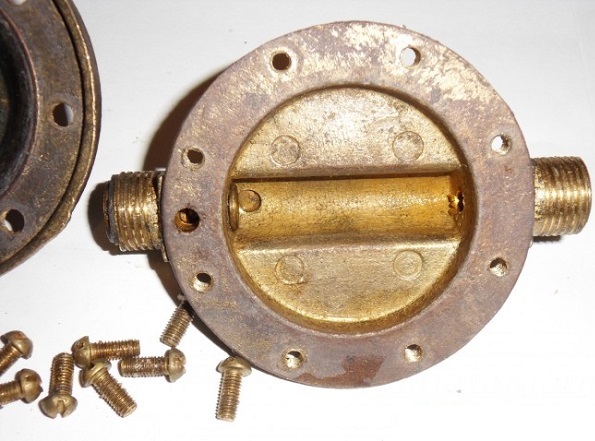
The screws should be screwed on and finally tightened without skewing. To do this, they are installed and baited in pairs-crosswise and similarly screwed all the way
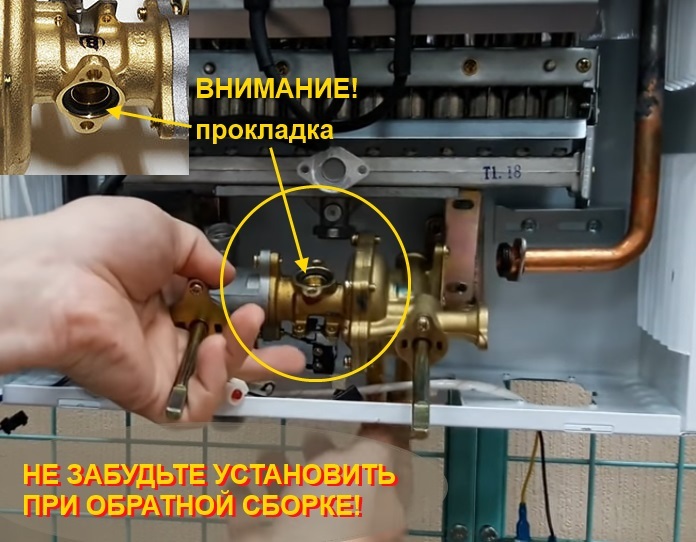
A gasket is installed in this place (between the burner and the gas unit). Be careful - the safety of the gas water heater is ensured by the tightness of this unit
Repaired node testing
After installing the repaired frog, we check the operation of the water part without connecting the gas by opening the hot water tap.
We observe:
- whether drops have appeared on the connections;
- whether the flow rate is the same when hot and cold water is turned on separately;
- whether the ignition device of the burner clicks;
- whether the stem moves normally when opening and closing the valve.
If everything is not going well, you should double-check your work. However, sometimes the reason may lie not only in the water unit.
Only after the mounted frog has passed the test, it is possible to supply gas to the column. But don't forget about safety rules when using a column. And if you smell gas, you should immediately shut off its supply, arrange ventilation and call the gas workers.
Conclusions and useful video on the topic
You can find out how to repair a frog of a Chinese water heater from the following video:
About the repair of the VU geyser Vaillant 24 \ 2 GRXI simply and clearly in this video:
The Bosch GK water unit can seem very complicated. However, many parts cannot be replaced individually, so you will have to buy a complete assembly. The good news is that dismantling and reassembling the node is simple:
The video explains why you should not delay replacing the stem oil seals, as soon as you notice the appearance of droplets. Shows how to disassemble the stem, replace the oil seals and reassemble:
In general, the device of any water block of a household gas water heater is quite reliably designed and manufactured. If the installation was performed correctly, and preventive inspections with timely replacement of consumables are carried out regularly, then problems with the operation of the columns do not occur often. It is not always necessary to have a specialist to repair the water heater unit. gas company. Many types of work can be done independently.
If you have any questions during the repair process that did not fit into the framework of the article, or you have a desire to share your solution problems - write about it in the comments, add unique shots of your own repair, give useful recommendations to others users.
